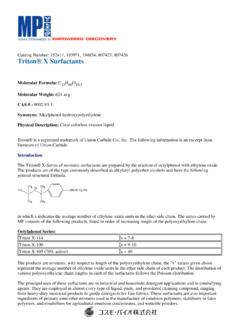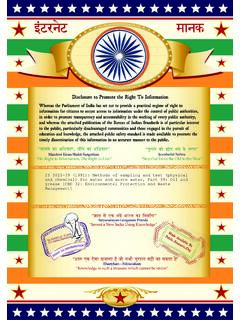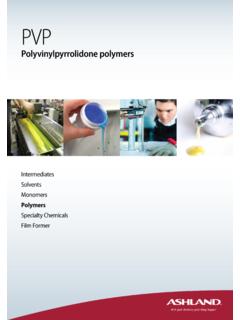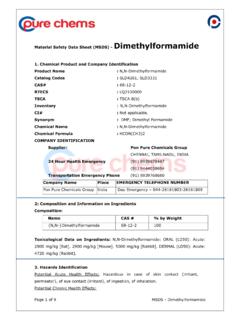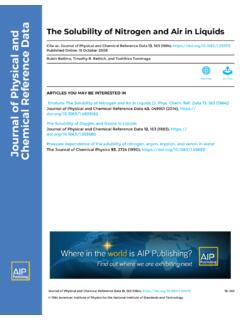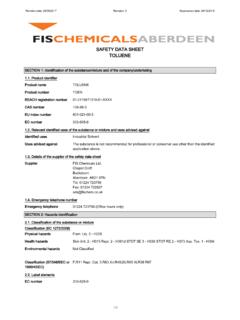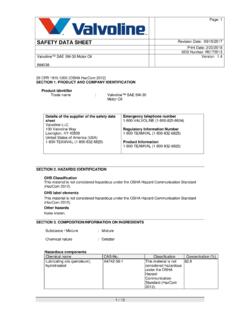Transcription of PRACTICAL LAB MANUAL
1 PRACTICAL LAB MANUAL . LAB MANUAL PHARMACEUTICAL ORGANIC CHEMISTRY-I. (B. Pharm Ist Year). CONTENTS. Chapters Pages Lassaigne`s extract (sodium fusion extract) and detection of 1. 1. elements 2 General pattern of functional group tests 4. 3. Functional group test: test for carboxylic acid 6. 4. Functional group test: test for alcohol 9. 5. Functional group test: test for phenols 12. 6. Functional group test: test for esters 16. Functional group test: test for carbonyl group- aldehyde and 7. ketone 17. Functional group test: test for primary, secondary and tertiary 8. amines 22. 9. Functional group test: test for anilides 26. 10. Functional group test: test for amides 27.
2 11. Functional group test: test for nitroso group 28. 12. Functional group test: test for carbohydrates 29. 13. Identification and reactions of hydrocarbons 30. 14. Derivative preparation 33. 15. Synthesis of aspirin 40. 16. Synthesis of oil of wintergreen 41. 17. Synthesis of p bromo acetanilide 42. 18. Synthesis of oxalic acid 43. 19. Synthesis of aniline 44. 20. Synthesis of phenytoin 45. 21. Synthesis of hydantoin 46. 22. Synthesis of paracetamol 47. 23. Synthesis of benzoic acid 48. 24. Synthesis of anthranilic acid 49. 25. Synthesis of picric acid 50. 26. Synthesis of hippuric acid 51. 27. Synthesis of barbituric acid 52. 28. Synthesis of 1,2,3,4-tetrahydrocarbazole 53.
3 29. Synthesis of 7-hydroxy-4-methyl coumarin 54. 30. Synthesis of 3-methyl-1-phenyl-5-pyrazolone 55. 31. Synthesis of 3,4-dihydro-1-hydroxy-4-oxophthalazine 56. 32. Synthesis of iodoform 57. 33. Some special/important reagents and their preparation 58. 1. LASSAIGNE`S EXTRACT (SODIUM FUSION EXTRACT) AND. DETECTION OF ELEMENTS. Lassaigne`s extract is prepared for the detection of nitrogen, sulphur, and halogens (Cl, Br, I) in an organic compound. These elements are covalently bonded to the organic compounds. In order to detect them, these have to be converted into their ionic forms. This is done by fusing the organic compound with sodium metal (Na). The ionic compounds formed during the fusion are extracted in aqueous solution and can be detected by simple chemical tests.
4 The extract is called sodium extract, sodium fusion extract or Lassaigne's extract. Organic Compound (containing C, H, O, N, S, X) + Na NaCN + Na2S + NaX + NaOH. (Where, X = Cl, Br or I). Test for nitrogen: The carbon and nitrogen present in the organic compound on fusion with sodium metal give sodium cyanide (NaCN) soluble in water. This is converted in to sodium ferrocyanide by the addition of sufficient quantity of ferrous sulphate. Ferric ions generated during the process react with ferrocyanide to form blue precipitate of ferric ferrocyanide. Na + C + N NaCN. 6 NaCN + FeSO4 Na4[Fe(CN)6] + Na2SO4. Sodium ferrocyanide Na4[Fe(CN)6] + Fe3+ Fe4[Fe(CN)6]3. Ferric ferrocyanide Test for sulphur: If sulphur is present in the organic compound, sodium fusion will convert it into sodium sulphide.
5 Sulphide ions are readily identified using sodium nitroprusside appearance of a deep violet colour indicates sulphur. Na + S Na2S. Na2S + Na2[Fe(CN)5NO] Na4[Fe(CN)5 NOS]. Sod. nitroprusside Sod. thio-nitroprusside (purple-violet colour). The presence of sulphur can also be identified by appearance of black precipitate (lead sulphide) after the addition of lead acetate. (CH3 COO)2Pb + Na2S 2 CH3 COONa + PbS. Test for both Nitrogen & Suphur together: If both N & S are present in the sample, then sodium thiocyanate (NaSCN) is formed with sodium (ionic form of nitrogen and sulphur together in the extract). Sodium thiocyanate -1- (NaSCN) reacts with ferric chloride to give ferric thiocyanate, a blood red colour complex.
6 Thus, the appearance of blood red colour indicates the presence of nitrogen and sulphur together. 3 NaSCN + FeCl3 Fe(SCN)3 + 3 NaCl Test for halogens (Cl, Br, I): Halogens (X) react with Na to form sodium halide (NaX). The sodium halide (NaX) is reacted with silver nitrate (AgNO3) to give precipitate of silver halide (AgX). A white precipitate (AgCl) soluble in ammonium hydroxide indicates the presence of chlorine. An off-white white precipitate (AgBr) partly soluble in ammonium hydroxide indicates the presence of bromine, while yellow precipitate (AgI) insoluble in ammonium hydroxide indicates the presence of iodine. NaX + AgNO3 AgX + NaNO3. PROCEDURE FOR LASSAIGNE'S EXTRACT (LE): Take a small piece of sodium metal with spatula and dry it in between the folds of filter paper.
7 Place the piece of sodium metal in an ignition tube and melt it, then add small amount of the given sample in the ignition tube. Heat the ignition tube over the flame till it become re hot. Take 20 mL of distil water in a china dish and crush the red-hot ignition tube (4-5 tubes) in it. Boil the mixture for 5 minutes and then filter it. This colourless filtrate is called sodium extract/sodium fusion extract/Lassaigne`s extract (LE). Perform different tests taking 1-2 mL of the extract for detecting the presence of element(s). A coloured filtrate indicates incomplete decomposition and the entire fusion procedure should be repeated. Chemical tests for detection of element(s): Test for Nitrogen Observation Take 1-2 mL Lassaigne`s extract (LE) in a test tube, add 2-3 crystals of ferrous sulphate (FeSO4) and boil it.
8 Add few drops of NaOH. A dirty green Prussian blue colour ppt is formed. Now add 2-3 drops of conc. H2SO4 by the walls of the test tube. The appearance of a Prussian blue colour (ferri- ferrocyanide). indicates the presence of nitrogen. Test for Sulphur 1. Take 1-2 mL LE and add few drops of sodium nitroprusside, if sulphur is present then sodium thio-nitroprusside is formed which is Purple-violet colour purple-violet in colour. 2. Take 1-2 mL LE and add lead acetate containing acetic acid. The Black precipitate formation of a black precipitate (PbS; lead sulphide) indicates the presence of sulfur. 2. Nitrogen and Sulphur present together Take 1-2 mL LE and add 2-3 crystals of ferric chloride.
9 If both nitrogen and sulphur is present then ferric thiocyanate is formed (blood red colour). Blood red colour Test for halogens (Cl, Br, I). To 1-2 mL LE, add 1-2 drops of HNO3 and then add AgNO3 solution. (i) The formation of a white precipitate (AgCl) that is soluble in White precipitate NH4OH indicates the presence of chlorine in the given sample. (ii) The formation of an off-white precipitate that is partially soluble in Off-white precipitate NH4OH confirms the presence of bromine. (iii) Where as the formation of a yellow precipitate insoluble in NH4OH Yellow precipitate confirms the presence of iodine in the given sample. Precautions: 1. Sodium metal is highly reactive, when exposed to air, it reacts even with the moisture present in the atmosphere.
10 It also reacts with the sweat of hands. Therefore, DO NOT hold it with hands. Always use dry forceps while handling sodium metal. 2. Before using sodium metal in any experiment, press it within the folds of filter paper to remove oil. 3. Use dry ignition tubes for sodium fusion. Sodium reacts with water violently. 4. Put the unused sodium metal piece back in its container. DO NOT throw it into the sink or dustbin. 5. Repeat the process of sodium fusion with at least three ignition tubes. This is to ensure that the fusion has taken place. 6. After immersing the red hot ignition tube in water, break it with glass rod gently. Boil the contents for 2-3 minutes so as to extract the soluble sodium salts in water.


